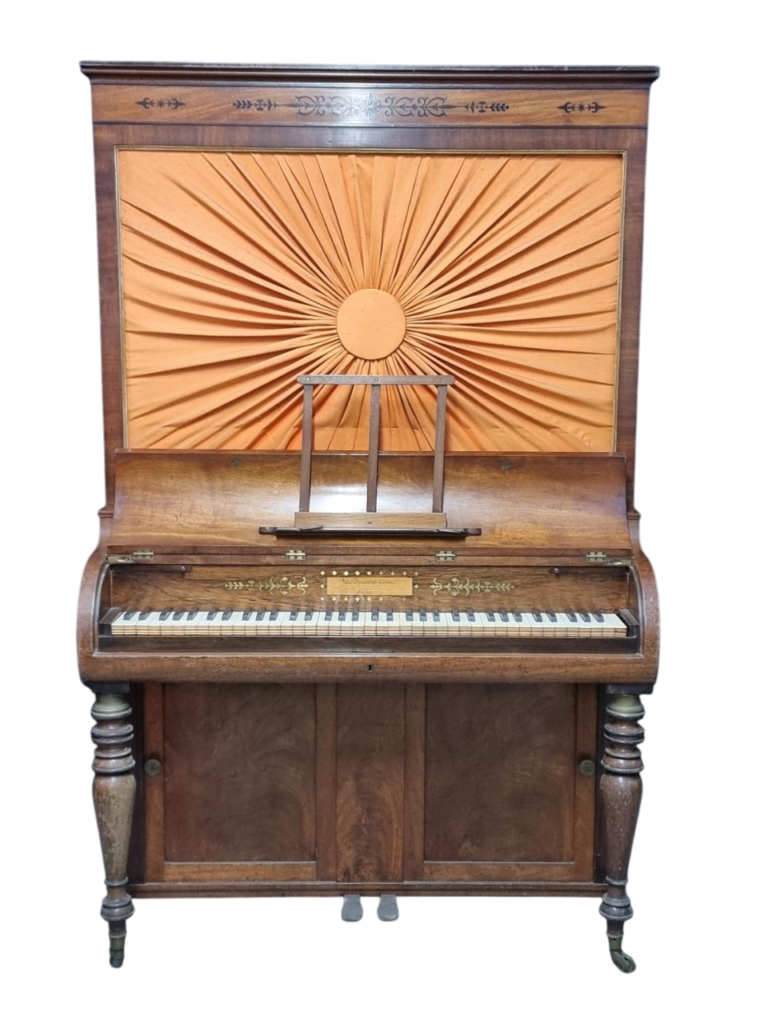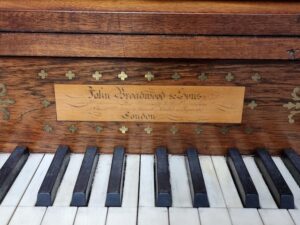Cabinet Piano John Broadwood and Sons c. 1820
Description

| Date: | 1820 |
| Origin: | London |
| Serialnumber: | 2652 |
At the beginning of the 19th century, the art of piano making in England underwent a phase of significant innovation and stylistic development. One of the most striking and imposing instruments of this period was the Cabinet Piano, a design that gained increasing popularity during the first half of the century, reaching its peak in the 1820s and 1830s.
The cabinet piano was a form of upright piano distinguished by its tall, often intricately decorated case, adorned with elaborate wood inlays, turned columns, and elegant embellishments that complemented the interiors of the affluent bourgeoisie. Unlike the smaller square pianos, it offered a more powerful sound and longer string length while occupying less space than a grand piano. Its tall soundboard and vertical construction allowed for greater string tension, resulting in a fuller and more resonant tone than earlier domestic instruments. The popularity of cabinet pianos endured until the mid-19th century but was eventually supplanted by the cottage piano, a more compact and practical version of the upright piano.
The instrument presented here was made around 1820 by John Broadwood & Sons in London. The case is made of solid mahogany and is richly decorated with ornate brass appliqués, while the front panel is covered with its original yellow silk. Stylistically, the instrument adheres to the Regency aesthetic, characterised by elegant, clean lines and intricate decorative elements.
The natural keys are covered with ivory, while the sharps are made of ebony. The instrument is equipped with two wooden pedals (dampers and una corda).
The hammers are leather-covered, and the instrument features a bichord stringing, ensuring a warm and resonant tonal quality. It features the English double-action with abstract levers, known for its precision and dynamic response. The nameboard is adorned with brass inlays and bears the signature:
“John Broadwood and Sons. / Makers to His Majesty and the Princesses /
Great Pulteney Street London Golden Square”

Cabinet Piano J. Broadwood and Sons,c. 1820 – Eric Feller Collection (signature)
This cabinet piano bears the serial number 2652. The tuning pins are positioned at the top. Beneath the keyboard, there are two small compartments with lockable doors. On either side above the keyboard, retractable candle sconces can be extended when needed.
This instrument is distinguished by its exceptional elegance and produces a rich, warm, and resonant tone, making it a remarkable example of early 19th-century piano craftsmanship.
John Broadwood was born on 6th October 1732 in Oldhamstocks near Cockburnspath in Scotland. He learned the profession of being a cabinetmaker like his father before.
In 1761 he started working for Burkat Shudi (1702 – 1773) in London and in 1770 became his business partner. In 1771 he opened his own shop on Great Pulteney Street in London. In 1769 he married Burkat Shudi’s daughter Barbara in her first marriage and had four children with her. After his wife’s death in 1776 he married Mary Kitson in 1781 and had six children with her. He died on 17th July 1812 in London.
Other surviving Cabinet Pianos by John Broadwood and Sons:
- 1827/28 Cabinet Piano (No. 3538) – Gemeentemuseum, The Hague The Netherlands
- 1828/29 Cabinet Piano (No.4042) – Metropolitan Museum of Art, New York USA

Cabinet Piano J. Broadwood and Sons, c. 1820 – Eric Feller Collection
| Length: | --- |
| Width: | 116,5 cm |
| Height: | 182 cm |
| Circumference: | 6 octaves (CC – c4) |
| Mechanics: | English double action with abstracts |
| Pedals: | 2 pedals (dampers and una corda) |
| Signature: |
"John Broadwood and Sons. / Makers to his Majesty and the Princesses / Great Pulteney Street Golden Square London " |

